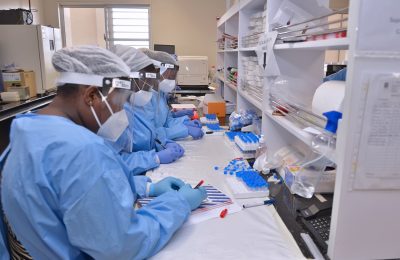- Home
- About
- Departments
- Research Activities
Advanced Research Center
Established in 2020
- Research Support Units
Co-ordinates All Activities Of The Institute
- Resources

HJF Project
Lead Investigator(s)

Linda Eva Amoah, PhD
HJF Project

Lead Investigator
Name of Lead PI
Project Summary
Project Background
Strategies to Develop New Field Blood Sample Diagnotics
Malaria remains one of the greatest threats to both health stability and deployed throughout the tropics and subtropics. In addition to constant concerns about the emergence of drug resistance parasites, there is recent evidence that the parasite is also developing resistance to detection with the currently used rapid diagnostic devices (RDTs). Recently, several groups have observed that populations of parasites are exhibiting increasing abundance of deletion mutations in precisely the genes that encode for the widely-used antigens in these RDTs. As a result, strains with those deletions are not detected and therefore those patients are not treated, which could allow progression to severe malaria and, possibly, death, in addition to enhancing the transmission of such mutant strains. The anticipated practical life span of these commercial point-of-care diagnostics is thus going to be much shorter than originally anticipated by their developers. When off-site, rather than point-of-care, analysis is required, a dried blood spot (DBS) card is the gold standard medium for the collection and stabilization of blood components. However, because of their minimalistic design, current DBS cards have a number of inherent disadvantages that limit their potential utility for malaria in particular. (i) Traditional DBS cards have no physical method of controlling the volume of sample applied to the paper card. Separate zones on DBS cards are loosely defined by a dashed circle to guide manual sample application by a user, which often results in heterogeneous sample spots that vary in quality the distribution of cells is not controllable. (ii) Once blood has dried on the card, biopsy punches are used to isolate sample discs for processing
For both diagnostics and for research, the preservation of RNA in the field remains an enormous problem. DNA is relatively stable, but unfortunately many types of viruses as well as staging many parasitic infections require the preservation of RNA. Currently, RNA cannot reliably be collected and preserved in far forward sites unless whole blood is collected into RNA preservation solutions, a cumbersome procedure when a finger-prick sample would suffice. Dried blood spots are often used in these situations, but again the reliability of RNA preservation is variable
Objectives/Research Areas
- Create a paper-based device that uses a single drop of blood to allow the isolation of Plasmodium DNA/RNA separately from host white blood cell DNA/RNA to facilitate downstream deep sequencing
- Create a second-generation paper-based device that can also stabilize and preserve Plasmodium DNA/RNA for downstream genetic profiling.
- Field test paper-based devices in countries endemic for falciparum, ovale and malariae (Ghana) and P. vivax, falciparum, and malariae (Peru). P. knowlesi is localized to Southeast Asia and will be tested in the future after our initial field optimization.
Ongoing activities
Ethics approval has been obtained, Phase I sample collection and field testing has ended, Phase II sample collection and field evaluation in preparation
Project Background
Strategies to Develop New Field Blood Sample Diagnotics
Malaria remains one of the greatest threats to both health stability and deployed throughout the tropics and subtropics. In addition to constant concerns about the emergence of drug resistance parasites, there is recent evidence that the parasite is also developing resistance to detection with the currently used rapid diagnostic devices (RDTs). Recently, several groups have observed that populations of parasites are exhibiting increasing abundance of deletion mutations in precisely the genes that encode for the widely-used antigens in these RDTs. As a result, strains with those deletions are not detected and therefore those patients are not treated, which could allow progression to severe malaria and, possibly, death, in addition to enhancing the transmission of such mutant strains. The anticipated practical life span of these commercial point-of-care diagnostics is thus going to be much shorter than originally anticipated by their developers. When off-site, rather than point-of-care, analysis is required, a dried blood spot (DBS) card is the gold standard medium for the collection and stabilization of blood components. However, because of their minimalistic design, current DBS cards have a number of inherent disadvantages that limit their potential utility for malaria in particular. (i) Traditional DBS cards have no physical method of controlling the volume of sample applied to the paper card. Separate zones on DBS cards are loosely defined by a dashed circle to guide manual sample application by a user, which often results in heterogeneous sample spots that vary in quality the distribution of cells is not controllable. (ii) Once blood has dried on the card, biopsy punches are used to isolate sample discs for processing
For both diagnostics and for research, the preservation of RNA in the field remains an enormous problem. DNA is relatively stable, but unfortunately many types of viruses as well as staging many parasitic infections require the preservation of RNA. Currently, RNA cannot reliably be collected and preserved in far forward sites unless whole blood is collected into RNA preservation solutions, a cumbersome procedure when a finger-prick sample would suffice. Dried blood spots are often used in these situations, but again the reliability of RNA preservation is variable
Objectives & Research Areas
- Create a paper-based device that uses a single drop of blood to allow the isolation of Plasmodium DNA/RNA separately from host white blood cell DNA/RNA to facilitate downstream deep sequencing
- Create a second-generation paper-based device that can also stabilize and preserve Plasmodium DNA/RNA for downstream genetic profiling.
- Field test paper-based devices in countries endemic for falciparum, ovale and malariae (Ghana) and P. vivax, falciparum, and malariae (Peru). P. knowlesi is localized to Southeast Asia and will be tested in the future after our initial field optimization.
Key Findings
Ongoing Activities
Ethics approval has been obtained, Phase I sample collection and field testing has ended, Phase II sample collection and field evaluation in preparation
Team

Sebastian S Kwapong
External Collaborators
Kim Williamson,
USUHS
Charles Mace,
Tufts University
Fiorenzo Omenetto,
Tufts University
Hugo Valdivia, PhD,
U.S Naval Medical Research Unit No. 6, Lima, Peru
Funders
Uniformed Service University of the Health Science







